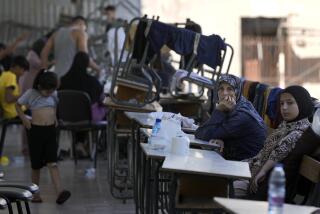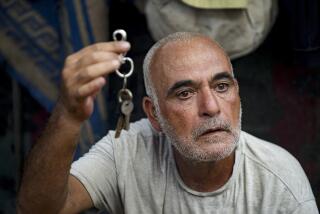Returning to a Place Where All but Hope Has Withered
DAKU, Afghanistan — From miles away, the ruined houses of the Shomali plain rise like giant sandcastles riven by the ocean.
Their towering walls loom over this broad valley that was emptied by the Taliban in a brutal campaign three years ago. About 200,000 people, by U.N. estimates, were banished from what was once some of the most fertile land in Afghanistan.
The Taliban is gone now, and the people have begun to trickle back. Today, the U.N. is set to begin the first large-scale resettlement of Afghans displaced by years of civil war.
But the return is at best a bitter victory for the farmers and villagers who used to live here.
“What can I do? I must come back, it is my homeland,” said Gul Mamoud, a farmer who escaped when the Taliban swept through.
“But when I left I had gardens of grapes, and plum trees whose branches in summer touched the ground because of the weight of the fruit. Now all my plants are dead, my house is burned. Look at me, I am old and poor,” said Mamoud, who returned for the first time over the weekend to survey his property.
His home, like others in the plain, had a striking design, with a three-story enclosure surrounding a large courtyard. The second-floor rooms had narrow windows reminiscent of those in medieval fortresses.
Now just the external walls remain, and many of those are damaged.
In the Shomali plain, one of this arid country’s few fruit baskets, the Taliban ravaged not just people and property but the land itself. Rows of stumps stand as testimony to a Taliban order to cut down the trees so enemies could not hide among the leaves. In many fields, the plants have dried beyond revival because irrigation systems were destroyed.
The story of the Shomali plain is one of great wealth turned to dust and now of a fragile hope for rebirth among the ruins.
The plain north of Kabul, the capital, has often been contested ground. The Russians and the Afghan moujahedeen fought here in the late 1980s, and there were brief battles when the Taliban first advanced on Kabul in 1996. But the worst damage came three years ago.
In 1999, angry that the Northern Alliance had pushed it out of the Panjshir Valley in the country’s northeast, the Taliban resolved to stop the enemy from coming any closer, said Wali Mohammed Nasei, professor of international law and politics at Kabul University. “They were afraid that the people in the area would join with the Northern Alliance and attack them,” he said.
So the Taliban moved into the plain, burning houses and shooting villagers. Then, to ensure that no one returned, they shoveled rocks and earth into the underground streams that are the main irrigation system for the orchards, blocking their flow. And they ordered the felling of many of the trees.
“The ruin that you see, the cut trees, the falling houses, all of that is from the fighting,” Nasei said.
Still, the villagers are coming back to this now bone-dry area and against all odds are beginning to rebuild. When the people left, they went in different directions, some to Kabul and many others to the Panjshir Valley, where they lived in camps for the internally displaced.
Although there is little to come back to, one look at the camps leaves little doubt why the inhabitants are so eager to leave: Tents are strung out across a desolate valley surrounded by snowcapped peaks, and the relentless wind plucks up every fragment of cloth not held down with stones. Many of the tents are no more than 8 feet square but house a family of six or more. The canvas is stretched on wooden poles that proved too weak during last year’s snow.
“It snowed last winter to the height of [about 4 feet], and the central beam broke and we were under the snow,” said Agha, 22, who represents a group of 42 families in one of the camps. “We had to buy [about 15 pounds] of wood to warm ourselves. If we go home to our villages, we will be able to use our dried grape trees and we will not have to pay anything for them.”
Agha and his uncle are already planning what they will do when they return to their village. First they will repair two rooms in their house so the family has shelter, and then they will turn to their fields. If the grapes, a local variety that grows on low bushes, cannot be revived, they will take them out and plant wheat and other grains that require less water.
“But if the stems are green when we cut them, then I will prune the dead wood and water my grapes and they will grow again,” Agha said.
Aid workers say they are in awe of the fortitude of the Afghans. “They have an enormous absorption capacity for taking hunger, loss of family and so much else,” said Maki Shinohara, a spokeswoman for the Office of the U.N. High Commissioner for Refugees.
The agency gives returning families the bare essentials for survival: window and door frames to use in rebuilding, blankets, children’s clothes, kitchen utensils, wood and charcoal.
More difficult is how to help returnees who are not aware of the U.N. aid programs.
“In principle we should be able to help those people who go back on their own, not just those who we transport back, but the question is logistically how to do it,” Shinohara said. There are scores of villages in the Shomali plain.
In Daku, several of the families that have returned are living in a house that was built by the Taliban. It is a psychologically disturbing arrangement for many of them.
“They killed my son, and his five children are orphaned. This is not my own home, and I do not feel well in it,” said Nafas Gul, a 60-year-old grandmother.
Northern Alliance soldiers set part of the structure on fire in a revenge burning not long before the families moved in, and the smell of smoke gives the children headaches, she said.
Such burnings are not uncommon in the Shomali, where on a winter afternoon three or four spirals of smoke rose at different points, evidence of recent arson by Northern Alliance soldiers. Why do they wreak such destruction now, when the war is over?
“Everyone has been damaged and is suffering,” said Zulmai Khan, who mans a nearby Northern Alliance checkpoint.
“They just do it to calm their nerves,” he said, dragging a stray piece of wood over to a fire that was slowly burning the wall of a Taliban home.
For most who return, though, the experience is one of reconciliation with loss.
Mamoud, a tall man with a face both elegant and sad, ducked through an opening in the wall and surveyed the land that once nurtured his treasured grape gardens. In the dying afternoon light, rows of bushes stretched out, dry and gnarled. He broke one off at the root with a light twist and then another and then another.
“Every one of these grape trees grew a crate of grapes,” he said, shaking his head in disbelief.
“If a dead man came into my garden, he would live because it was such a beautiful place. I thought I was a king. But it is as it is. It is not good, but at least our homeland is free.”
More to Read
Sign up for Essential California
The most important California stories and recommendations in your inbox every morning.
You may occasionally receive promotional content from the Los Angeles Times.










